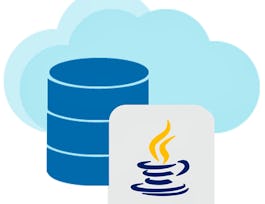This is the fourth course in the Amazon Junior Software Developer Professional Certificate. In this course on Introduction to Databases and Basic SQL Queries, you will learn essential knowledge and skills for working with relational databases and querying data using SQL (Structured Query Language). You'll start by understanding fundamental concepts like tables, rows, and columns and learn to write basic SQL queries for operations such as selecting, inserting, updating, and deleting data. You'll interact with the command line to create, populate, and query a simple database. Moving on to SQL Queries, you'll explore advanced topics, including retrieving data from multiple tables using JOINs, filtering data with WHERE clauses, and sorting/grouping data using ORDER BY and GROUP BY clauses, enabling efficient data manipulation within databases. Subsequently, you will delve into JDBC Fundamentals, gaining insights into JDBC (Java Database Connectivity), setting up JDBC drivers and connections, executing SQL queries and commands with JDBC statements, establishing database connections using DriverManager and DataSource, managing database connections effectively, and executing DDL and DML statements for database schema management and data manipulation. By the end of this course, you will be proficient in working with databases, writing SQL queries, and utilizing JDBC to interact with databases in Java applications.



Database Management with Java and SQL
This course is part of Amazon Junior Software Developer Professional Certificate

Instructor: Amazon
Sponsored by Syrian Youth Assembly
Recommended experience
What you'll learn
Discuss different types of common database configurations.
Manipulate datasets with Java programming tools and techniques.
Illustrate the process of data querying and retrieval using SQL with JDBC.
Details to know

Add to your LinkedIn profile
14 assignments
November 2024
See how employees at top companies are mastering in-demand skills

Build your Software Development expertise
- Learn new concepts from industry experts
- Gain a foundational understanding of a subject or tool
- Develop job-relevant skills with hands-on projects
- Earn a shareable career certificate from Amazon


Earn a career certificate
Add this credential to your LinkedIn profile, resume, or CV
Share it on social media and in your performance review

There are 4 modules in this course
This module lays the foundation for understanding and working with databases. It covers the fundamentals of database systems, including table structures, data types, and relationships. You'll learn essential SQL skills for querying and manipulating data, starting with basic filters and progressing to more complex operations like sorting and aggregating. The module then explores various join techniques, teaching you how to combine information from multiple tables effectively. Through a mix of theoretical concepts and hands-on activities, you'll gain practical experience in database creation, querying, and data retrieval. By the end of this module, you'll have a solid grasp of basic database principles and SQL operations, preparing you for more advanced database concepts later in the course.
What's included
18 videos10 readings5 assignments1 discussion prompt4 ungraded labs
In this module, you'll explore how to connect Java applications with databases using JDBC, starting with the basics of JDBC architecture and how to make your first database connection from Java. You'll learn how set up your environment, load drivers, and establish connections. You'll also dive into connection management, covering handy techniques like using DataSource and taking care of connection lifecycles. As you progress, you'll also explore working with Data Definition Language (DDL) and Data Manipulation Language (DML)—learning how to create, modify, and drop tables, and handle transactions like a pro. Through interactive activities and practical exercises, you'll build the skills needed to write Java code that smoothly interacts with databases, setting you up to create strong, database-powered applications.
What's included
15 videos8 readings4 assignments1 programming assignment4 ungraded labs
In this module, you'll dive into building graphical user interfaces (GUIs) for database apps using JavaFX. You'll start by setting up projects and creating basic GUIs, getting hands-on with event handling. Then, you'll connect your JavaFX apps to databases, learning how to fetch and display data smoothly. You'll also tackle error handling for database operations. As you progress, you'll explore advanced UI techniques like using SceneBuilder for design, data binding, and adding features like search. By the end, you'll confidently create interactive, database-powered Java applications.
What's included
12 videos4 readings4 assignments1 programming assignment4 ungraded labs
In this final module, you'll bring everything together from the course to build a Library Management System as your capstone project. You’ll get hands-on experience integrating database design, SQL, Java programming, and JavaFX to create a complete application. Along the way, you'll reflect on your learning through a self-assessment and a final quiz, helping reinforce key concepts. You’ll also look ahead to explore potential next steps in your database management and Java programming journey, setting the stage for future growth.
What's included
2 videos2 readings1 assignment1 programming assignment1 discussion prompt1 plugin
Why people choose Coursera for their career




Recommended if you're interested in Computer Science

LearnQuest

LearnQuest

Coursera Project Network

Open new doors with Coursera Plus
Unlimited access to 10,000+ world-class courses, hands-on projects, and job-ready certificate programs - all included in your subscription
Advance your career with an online degree
Earn a degree from world-class universities - 100% online
Join over 3,400 global companies that choose Coursera for Business
Upskill your employees to excel in the digital economy



